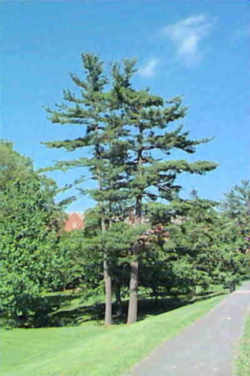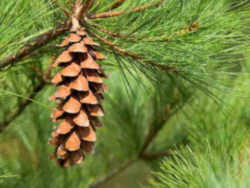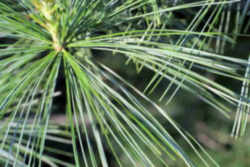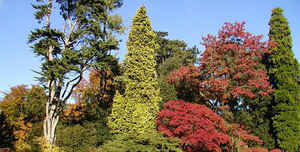Michigan State Tree
Eastern White Pine

(Pinus strobus L)
Adopted on Oct. 14, 1955.
The eastern white pine, (Pinus strobus L) is also known as "soft pine was designated as Michigan state tree by Public Act 7 of 1955 effective Oct. 14, 1955 "It was called the Tree of Peace by the Iroquois and in Ojibway, Zhingwaak. Mature white pines can easily live 200+ years of age, with some Michigan trees that have approached 500 years in age. The eastern white pine has the distinction of being the tallest tree in eastern North America, and pre-colonial stands were reported over 200 feet in height.
The towering eastern white pine, (Pinaceae Pinus strobus,) is a symbol of one of Michigan's greatest industries--lumbering. From 1870 to the early 1900s, Michigan led the nation in lumber production. During those years a transportation network and communities grew across the state to accommodate the lumber boom.
Michigan State Tree: Eastern White Pine

Pinus strobus, commonly known as the eastern white pine, white pine, northern white pine, Weymouth pine, and soft pine is a large pine native to eastern North America. It occurs from Newfoundland west through the Great Lakes region to southeastern Manitoba and Minnesota, and south along the Mississippi Basin and Appalachian Mountains to northernmost Georgia and Mississippi.
Eastern white pine is one of the most valuable trees in eastern North America. Before the arrival of white men, virgin stands contained an estimated 3.4 billion m? (600 billion fbm) of lumber. By the late 1800's most of those vast stands had been logged. Because it is among the more rapid growing northern forest conifers, it is an excellent tree for reforestation projects, landscaping, and Christmas trees and has the distinction of having been one of the more widely planted American trees.
Identification of the Eastern White Pine

- Leaf: Evergreen, 3 to 5 inches long, with five blue-green, slender needles per fascicle. A fascicle sheath is not present. Needles appear blue because of 3 or more lines of stomata.
- Flower: Monoecious; males cylindrical, yellow, in clusters near branch tips; females light green, tinged in red, at ends of branches.
- Fruit: Cones are 4 to 7 inches long, cylindrical, with thin, rounded cone scales, very resinous. Cones are borne on a long stalk. Maturing August to September.
- Twig: Slender, gray-green to orange-brown in color.
- Bark: On young trees; thin, smooth and gray-green in color. Later becoming thick, reddish-brown to gray-brown with prominent ridges and furrows.
- Form: A large tree with a very straight stem. The crown is conical when young, later developing wispy, horizontal branches.
Michigan Compiled Laws
The law designating the white pineas the official Michigan state tree is found in the Michigan Compiled Laws Chapter 2 (STATE) Act 7 of 1955 Statute.
Act 7 of 1955
AN ACT to adopt the white pine (Pinus strobus, L.) as the official state tree for the state of Michigan.
The People of the State of Michigan enact:
2.31 State tree.
Sec. 1. The white pine (Pinus strobus, L.) is hereby adopted as the official state tree for the state of
Michigan.
History: 1955, Act 7, Eff. Oct. 14, 1955.
Taxonomic Hierarchy: White Pine Tree
Kingdom: Plantae - Plants
Subkingdom: Tracheobionta - Vascular plants
Superdivision: Spermatophyta - Seed plants
Division: Coniferophyta - Conifers
Class: Pinopsida
Order: Pinales
Family: Pinaceae - Pine family
Genus: Pinus L. - pine
Species: Pinus strobus L. - eastern white pine








